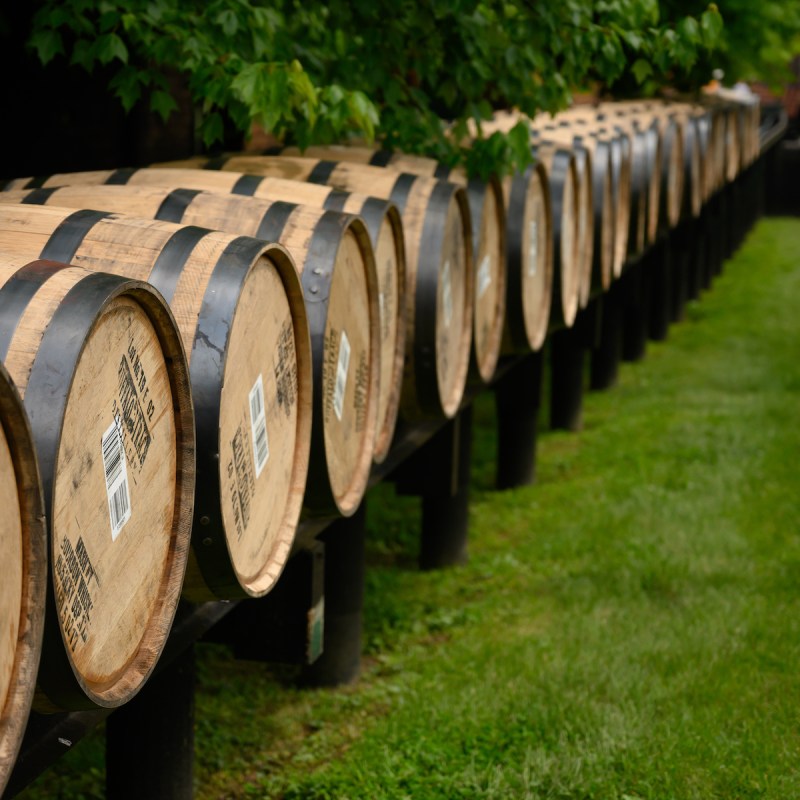
The Kentucky Bourbon Trail, which covers a portion of western Kentucky, is not just for people who want to taste bourbon. Scattered through this bluegrass country are rolling hills with magnificent horse ranches, fabulous food, and music.
Videos by TravelAwaits
However, for people who appreciate bourbon, here’s an opportunity to expand your knowledge of the kinds of bourbon and even talk to the people who make their livelihood creating this spirit, which is growing in popularity.
I was invited to the area by Chilled Magazine, so some of the information I provide below was learned from attending a conference in Louisville, Kentucky.

1. Bourbon Vs. Whiskey
All bourbon is whiskey, but not all whiskey is bourbon. Confused yet? I certainly was until I got this explanation from one of the distilleries I visited. Three things are necessary for it to be called bourbon.
- Bourbon must be made of at least 51 percent corn.
- Bourbon must be aged in a new charred American white oak barrel. Since a charred barrel is needed, the Brown-Forman Cooperage, located in Louisville, takes new barrels and literally sets them on fire for a short time before extinguishing them. When you look inside, they are black from the fire, thus called charred.
- Bourbon must be at least 80 proof.
A way to further describe: Bourbon is a type of whiskey — think champagne to wine.
2. Sip And Swish Like An Expert
Smiling, for who knew there was a way prescribed by bourbon experts? Okay, I have a lot yet to learn about bourbon. There wasn’t a day that went by that I did not learn more about the world of bourbon.
The process is:
- Take a small taste to wake up your tastebuds.
- Take a second small sip and swish it around in your mouth — not like mouthwash, but you get the picture.
- Take another sip and pay attention to the flavor that dances on your palate.
There you have it! The formula to help you make it look like you know what you are doing as you transverse this beautiful trail.
Pro Tip: Bourbon tastings range in price from $5 to $20. You must have a valid ID. Samples are 1.7 ounces.

3. Appreciate The Trail’s History
The history of bourbon-making goes back to the late 1700s. Thirsty travelers navigating the Ohio and Mississippi Rivers made stops here for this enticing beverage created by the locals. This county was Bourbon. Thus, the name, Bourbon, was given to this intoxicating beverage.
Seeing a need over 150 years ago, Stoneware & Co. started making stoneware vessels from local clay. Thus, visitors were able to fill the pots with bourbon for their journey. As the boats traversed the Mississippi and Ohio, people were introduced to bourbon, which varied according to the maker.
With ideal conditions and the market there, more and more people started making their own bourbon. Distilleries proliferated and sent their bourbon brand off to other places in the world.
Member distilleries of the Kentucky Distillers’ Association realized they had a unique visitor attraction if they banded together to promote the area. It would be good for all the distilleries, restaurants, and bed and breakfasts scattered throughout the area. Thus, the Bourbon Trail was established in 1999.
Pro Tip: I recommend you make a reservation and take a tour of Stoneware & Co.
4. Take The Trail Slow
Naïvely, before I went to Kentucky, I assumed that one could cover the Bourbon Trail in a couple of days. Then I learned it is 70 miles long and travels through the towns of Bardstown, Frankfort, Lebanon, Lexington, Owensboro, and Louisville. With 42 distillery stops with an average visit of 90 minutes, you see that navigating the trail in a couple of days is not doable.
Besides, after my experience of a couple of bourbon tastings, taking a tour of the distilleries, talking with locals, and browsing in their individual gift shops, the day is over before you know it.
The ideal way to explore is to plan to take a week. Enjoy the beautiful countryside, stop when you feel like it, and try wonderful Southern cuisine at the restaurants dotted along the trail.

5. Start At Frazier History Museum
If you are flying or driving into Louisville, I suggest you find your way to The Frazier History Museum, an affiliate of the Smithsonian. Located in the center of Louisville, this museum tells the story of Kentucky’s history and, thus, the bourbon industry for which it has become so famous.
Not only do you get a rich historic perspective, but you will also see before you in one room the breath of the kind of bourbon and whiskey that is now trademarked by various distilleries. I stood there in amazement as I viewed the hundreds of different types of bourbon and whiskey in bottles lit from behind.
This exhibit quickly brings into perspective that not only is this a serious industry — Kentucky has taken full advantage of its natural resources, a plentiful water supply, and limestone.
At the entrance to the museum, on the wall, is a giant map. Thankfully, the desk clerk is happy to hand you a pocketbook-sized map at the desk that will serve as your official guide to follow the trail.

6. Tour One Of The Oldest Kentucky Bourbon Trail Distilleries
Four Roses Distillery
At the Four Roses Distillery in Lawrenceburg, Kentucky, you can witness the entire process of making bourbon. With its beginnings starting in 1888, it still only has 10 distinct bourbon recipes. These recipes are constantly rebalanced to create Four Roses, Small Batch.
The tour takes you into the single-story warehouse, where you can peer into vats where the base mixture is fermenting. A vat may have bubbles acting like they are vying for attention, and another one contains bubbles lazily spending their time surfacing — it depends on what stage of the process the mixture is at the time.
A large portion of Kentucky is on a bed of limestone. When it rains, the water filters through the limestone and adds nutrients like calcium and magnesium, both of which help activate yeast during the fermentation process. Plus, the limestone removes the iron from the water, considered an impurity that gives liquor a bad taste.
One of the fun aspects of this tour is that you can dip your finger into the vat and taste the fermenting liquid. From experience, I can tell you the mixture tastes different from each one of the vats — definitely a yeast taste at this step.
After the tour, you head up to their brand-new building, where the tastings are held. Here, you enter a large room, and one of the staff shares historical information about the distillery and its process for producing small batches and explains the attributes of the samples set before you in small glasses.
With all this new knowledge, you will find spending time in their expansive gift shop is truly a delight. Filled with recipe books and glasses of various sizes, bartending tools, and of course, you can purchase bourbon.
Pro Tip: Reservations are required for the tours and tastings. See the websites of the various distilleries for current prices and times.

7. Visit During Off-Season
With approximately 2.5 million people coming to Kentucky for tastings, you can imagine the narrow winding country roads can get a bit crowded. Locals recommend that November through March is a time when you can avoid the crowds. I went in December and found that the master distillers were not rushed for time, so they enjoyed sharing the specifics of their processes.
Here’s an interesting statistic: 95 percent of the world’s bourbon, approximately 9 million barrels, is aging at any one time. Thus, you can be sure that no matter what time of year you go, there will be things to see and experience.
I’ve covered probably 20 miles of the Bourbon Trail. Is it enough to quench my curiosity about the trail? No, it is not. If you have been to wineries, you know they are all different and have their own story to tell. The same is true of the distilleries. Remember you are also driving through bluegrass country, which is also known for its beautiful scenery, and we cannot forget its music.
If this area is not on your bucket list, I suggest you seriously consider adding it. It is not going away. However, I expect it will get even more crowded as people look for ways to get out in nature. Plus, you know old fashioneds are making a big comeback, and this aficionado was pleased to learn more about the spirit that is finding its way into more craft cocktails.
Update: As I was finishing this article, one more distillery, Whiskey Thief Distilling Co., has been added to the Kentucky Bourbon Trail, which now consists of 43 distilleries.
For more information on traveling to Kentucky, check out these articles:
